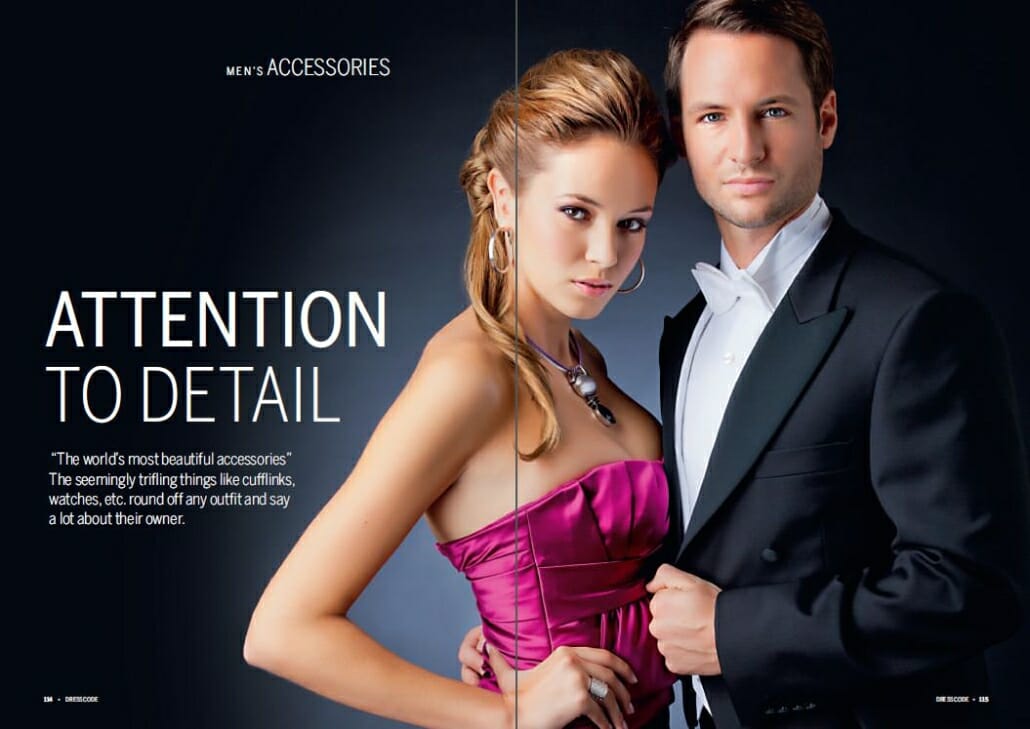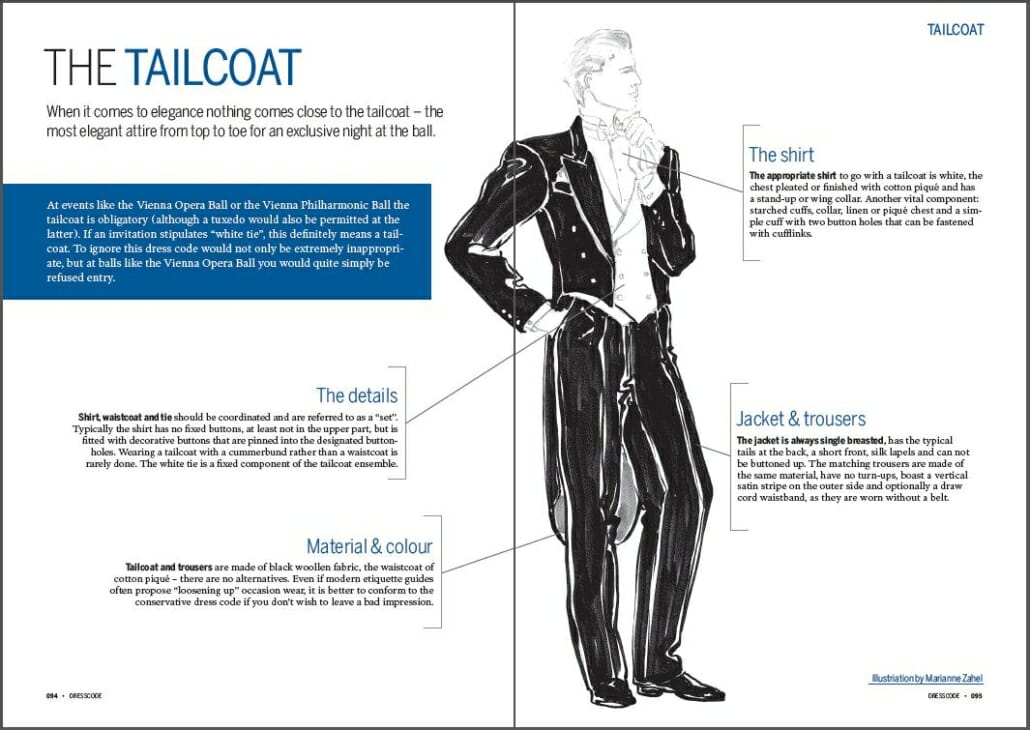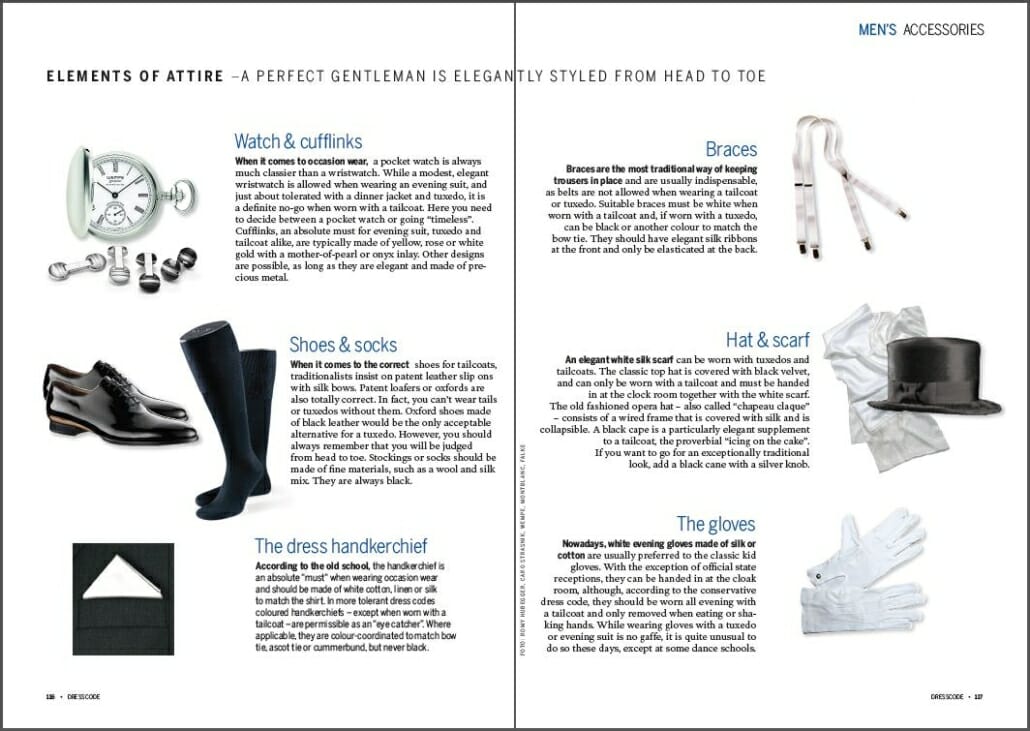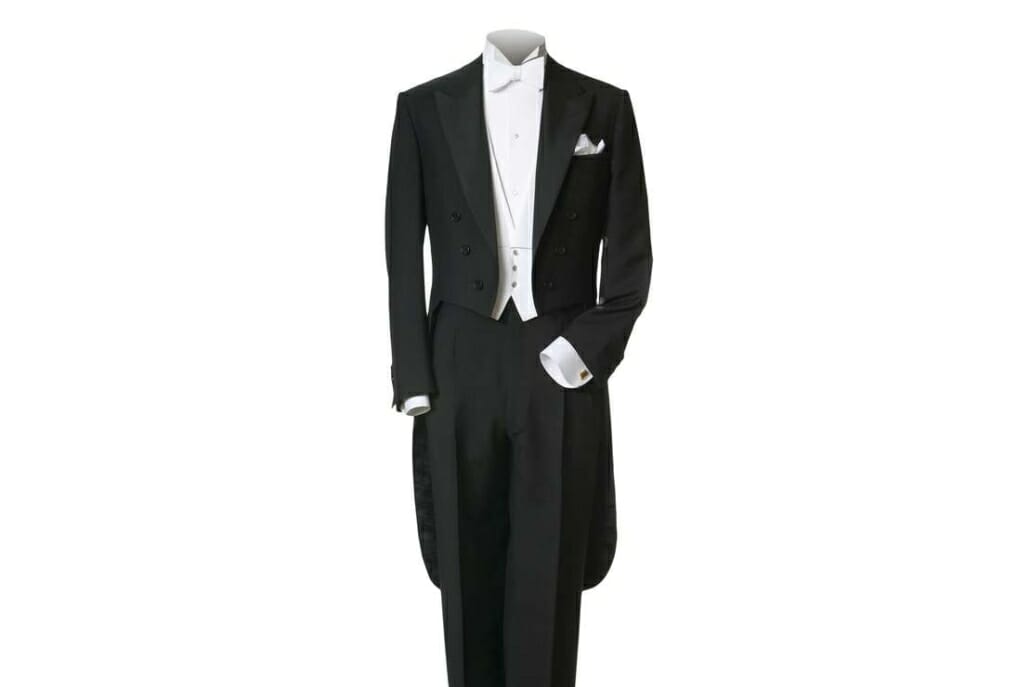While writing a recent post on Vienna’s famous balls I stumbled across a remarkable booklet called DRESSCODES that is devoted entirely to the dress etiquette for these affairs. I say “remarkable” because in an age where vulgarity and slovenliness is increasingly fashionable, Vienna’s social leaders have the audacity to suggest that people hold themselves to a higher standard. Unlike most organizers of formal events who have resigned themselves to bourgeois apathy, this brave group is standing fast with a slick 160-page publication that not only explains conventional dress codes but outright celebrates them.

Based on the book’s introductory comments, preserving these traditions is a challenging task. Ball organizers agree that knowledge of formal dress codes is not very wide spread today (thanks partly to reference books that are sparse and/or misleading) and this ignorance “is something that becomes an issue at almost every ball”, particularly among younger guests. The problem even extends to some celebrity guests of honor who show up in a business suit or short dress. This is particularly vexing for organizers because photos of these VIPs are then splashed across the media leading the masses to infer that such inappropriate attire is perfectly acceptable. Says one organizer, “Especially the many international guests have difficulties knowing and following the correct dress code for a night at a Viennese Ball.” This no doubt explains why the Austrian publication is offered in English. (American English, to be precise.)
Echoing the sentiments of The Black Tie Guide’s Etiquette section, the booklet points out that correct observation of dress codes helps give an event its special flair and ambiance, provides guests with a sense of security and comfort, and displays courtesy towards the host. To make such observation as easy as possible the authors list the applicable dress codes for each ball then describe each of them in considerable detail. (It turns out there is actually a great deal of variety allowed: White Tie is mandatory only at two of the 26 listed balls.)

For more specifics on the white tie dress code, check out our White Tie Guide and white tie accessories.
The specifics of the traditional evening dress codes are also virtually identical to The Guide’s conventional advice which means that Austrian customs very closely mimic those of the British. There are some slight variations though:
- For White Tie a cummerbund is described as “rarely done” yet not specifically prohibited. Also surprising is the fact that the shirt can have a pleated chest. A more orthodox variation is the allowance for a stand-up collar which hearkens back to 19th century formal attire.
- For Black Tie coloured bow ties and cummerbunds are acceptable for “very modernly styled gentlemen”, there is no mention of waistcoats – only cummerbunds (accompanying photos show the same bias) and modern allowances are made for shirts with silk fabric and fly fronts. One significant departure from British Black Tie convention is the equal weighting given to turndown and wing collars.
Rounding out the publication’s list of “occasion wear” are military uniforms – referred to by the booklet as Gala Uniforms and acceptable at most functions that call for tailcoats or tuxedos – and two alternative dress codes unique to Austrian ball culture:
- “The Dark Suit” may sound quite informal but in fact comes with numerous stipulations that steer it towards the realm of Black Tie and even then is appropriate for only a few balls. Notably, these are the only jackets to feature notched lapels; dinner jackets shown in the booklet all sport either peaked lapels or shawl collars.
- “Festive National Costume” is also limited to a small number of balls and also comes with strict qualifiers: Only formal versions of national costume are allowed and the costume must be authentic rather than improvised. Also, the costume must correspond with the wearer’s nationality; wearing a kilt when you haven’t a drop of Scottish blood in you is “totally taboo”.

Finally, the authors’ dedication to raising the bar is probably most evident in their sophisticated recommendations for appropriate accessories. Here’s a sampling:
- “While a modest, elegant wristwatch is allowed when wearing an evening suit, and just about tolerated with a dinner jacket and tuxedo, it is a definite no-go when worn with a tailcoat. Here you need to decide between a pocket watch or going ‘timeless.”
- Patent leather shoes are obligatory with tailcoats and “oxford shoes made of black leather would be the only acceptable alternative for a tuxedo. However, you should always remember that you will be judged from head to toe.”
- “A black cape is a particularly elegant supplement to a tailcoat, the proverbial ‘icing on the cake’.”
- “With the exception of official state receptions, [white evening gloves] can be handed in at the cloak room, although, according to the conservative dress code, they should be worn all evening with a tailcoat and only removed when eating or shaking hands.”
The results of this careful attention to detail and courageous defense of tradition speak for themselves. Rather than being gradually downgraded into just another series of dances, the Vienna Balls have established themselves as the pinnacle of elegance. In fact, in 2010 UNESCO named several of them as part of the world’s Intangible Cultural Heritage.
________________________________________

Some fun facts about the Vienna Balls in general:
- some of the balls date back over four centuries
- ball season runs from January to the start of the Christian Lenten observance in spring
- most balls are held at Hofburg Palace, former winter residence of the Habsburg dynasty and current official residence of the Austrian President
- the balls were originally held for members of particular professions ranging from pharmacists to confectioners; over time they have opened up to other members of the public
- in the spirit of Europe’s lavish upper class balls of the 18th and 19th centuries, Vienna’s balls start late (9 PM is typical) and last until the early morning (at least one of them doesn’t wrap up until 5 AM)
- the balls have a very structured agenda of events such as an opening ceremony, midnight stage show and dance and music performances
- light snacks are served to fuel guests throughout the night
- ending the night with breakfast at a local coffee house is a longstanding tradition
(And I also learned that “Wiener” is German for “Viennese”!)
Good to see that there’s still somewhere where full formal dressing still happens. Would just like to say that waistcoats are mentioned on p. 24, but not in the main dinner jacket section.
Also, I found the use of “dinner jacket” to mean “white dinner jacket” quite disconcerting. While I understand the usage is American, I think in any international discussion “dinner jacket” and “tuxedo” should be synonymous and refer to the traditional dark jackets. White variants can be designated as such.
Perhaps it’s just me, but I’d find it less confusing.
Dear RPC,
The usage of dinner jacket to mean the white, or actually ivory, evening jacket appropriate for summer events and tropical cruises is unique to the German-speaking world. I am half-English and half-Bavarian/Austrian (from mum’s side), and the word for the black dinner suit is Smoking, with a capital “s”. My mum would always refer to my dad’s dinner jacket as Smoking in family conversations, but not in public.
Now that I think about it, the French might use it as well, as they refer to black tie as either cravate noire or le smoking. It is probably derived from the English term smoking jacket. I find etymology fascinating, and always wonder how certain words came into being, and how different cultures adapted their usage.
Cheers,
Kate
Dear Kate,
Thank you very much; I understood from the early pages of this Guide that the use of “dinner jacket” for the cream summer version was a North American one, but it’s good to know the origin of that usage.
It is indeed fascinating to examine the history of words, especially when the history of the terms is so intimately tied up with the history of the traditions they denote, and so informs our current understanding of those very traditions.
Best wishes,
RPC.
As explained in the Black Tie Guide history section, in North America the terms “dinner jacket” and “tuxedo” were interchangeable until the 1950s when the coloured jacket became popular and people began to reserve the latter term for the black suit only.
Shame that that fashion illustrations appear to have escaped from the 1980s at their worst – complete with New Romantic styled flicked hairstyles and suits that don’t fit. We should probably be grateful the sleeves aren’t pushed up.
On the issue of the dark suit as evening wear, this seems to have a lengthy and honourable history in the german speaking world. Gentleman’s Gazette have this illustration of three types of evening suit ( http://www.gentlemansgazette.com/wp-content/uploads/2012/10/Evening-Wear-Tuxedo-White-Tie-Lounge-Suit.jpg ) and I’ve seen an example at the fedora lounge boards too of a dark suit worn as an alternative.
Personally, I don’t really get the advice given in the Viennese Ball guide on the dark suit. Why wear a dark suit with elements from the dinner jacket? Either wear a proper dinner jacket and bow tie or wear a good suit with a long tie would be preferable, I’d’ve thought.
I do find it ironic that on the picture for the section entitled: Attention to Detail, that the gentleman’s coat sleeve is far too long with no shirt cuff exposed at all. Maybe not too surprising if you take a look at the full guide – the editor’s picture (above his editorial) shows him wearing his dress shirt with the wings of his collar floating oddly above his tie.
I must thank Peter for putting the Guide together and making dressing correctly so easy! However, I will admit that I now quickly notice all the glaring errors in how others dress – something that I blithely overlooked in the past – and it now makes me absolutely nuts!!
Dear Peter,
Thank you for this post and your wonderful Black Tie Guide, which has proven so very helpful for so many people. I picked up a glossy hardcopy of this publication whilst in Austria last month. I understand that not everything listed in it may meet the traditional English guidelines, but the dress standards in Vienna are far higher than in the United States where hired attire prevails. Most Austrians, and especially the Viennese, own evening wear, because the many, many balls (300+) per season offer plenty of opportunities for wearing dinner jackets and tailcoats.
Most gentlemen stick with black bow ties and black cummerbunds, the waistcoat is indeed rare, but at the big, traditional balls, the majority of male guests is in white tie even though it is not mandatory. The tailcoat, or Frack, as it is called in German, is experiencing a renaissance, and Vienna’s oldest shop, Lambert Hofer, requests advance reservations according to a report by Austrian TV ORF to ensure that supplies can meet demand.
I have never seen somebody turned away from an American event for not following the dress code, not even the male guest who showed up in a light brown lounge suit and tasseled slippers at a prestigious country club Christmas Ball that stipulated either white or black tie! I have seen people refused entry in Austria and the UK. I very much agree with you, the authors of this publication, and others who say that guests play an important role and are active participants rather than spectators. Everybody contributes to the ambiance and atmosphere. Whilst a few improperly dressed guests may not detract from the overall elegance, this is not the case once they reach critical mass. Nip it in the bud — as my granny always used to say.
Cheers,
Kate
Thanks Kate. I always appreciate insider perspectives on formality around the world!